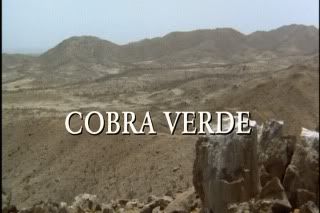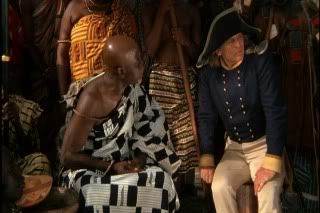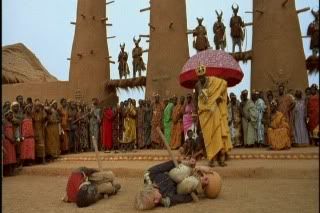
PLOT:
The final film in the legendary collaboration between director Werner Herzog and actor Klaus Kinski, COBRA VERDE--based on a novel by Bruce Chatwin--tells the story of Francisco Manoel da Silva, a poor farmer who raises himself to fame and notoriety as the bandit “Cobra Verde.”
The film begins with a blind minstrel beginning to sing the tale of the famed bandit. Da Silva is shown kneeling before a cross; surrounding him is a dead, parched landscape. It’s only because I read a synopsis of the film that I know that this is supposed to be his land, destroyed by draught (the film itself makes no mention of this). And so da Silva is forced into a job as a gold miner, only to disagree with his foreman over his payment. Having exhausted the legitimate means available to him for making a living, da Silva murders the foreman and turns to a life of crime, as the bandit Cobra Verde.
Soon, he finds himself in the employ of a sugar baron named Don Octavio Coutinho. Rather than attending to his duties, da Silva impregnates each of the sugar baron’s three daughters, before revealing himself as the bandit Cobra Verde. As punishment, he is sent to the African kingdom of Dahomey, where he is to reopen the slave trade by negotiating with the mad King Bossa Ahadee. The sugar baron assumes that Cobra Verde will fail, and be murdered in the process. Of course, the bandit succeeds, becoming the Viceroy of Dahomey, and eventually leading an army of amazons in the process.

REVIEW:
COBRA VERDE is often considered the weakest of the Herzog-Kinski collaborations. I have to disagree with this popular assessment. I find the alienation in WOYZEK is so intense that I, as the viewer, felt it as well, and in doing so was almost completely unable to enjoy the film. And something about NOSFERATU has never sat right with me, as much as I admire it. COBRA VERDE, on the other hand, is as engrossing as the earlier Herzog-Kinski collaborations, AGUIRRE and FITZCARRALDO.
This film is different than those two, though, in very important ways. For one, the focus in both of those films is the obsession (and insanity) of the main character, as played by Kinski. They are character-driven, rather than plot-driven (and indeed almost all of these films suffer from a lack of clear narrative, to my mind). COBRA VERDE, on the other hand, is a plot-driven piece; it has a detailed narrative, with several easily-distinguishable acts, as well as lots of action.
Among the chief pleasures to be derived from any Herzog film is the filmmaker’s eye for composing a breathtaking shot, and his engagement with the world of the film. Look how he uses the colourful costumes of the Dahomey people to serve as a living background for Cobra Verde:

There are almost no sets in Herzog’s films; everything is shot on location, using real buildings, and often real people (as opposed to “fake” actors, I suppose). It adds an element of reality to his films that doesn’t necessarily make a “better” movie, but it has a striking effect that you can’t find elsewhere. For instance, the image that first comes to my mind, when I think of FITZCARRALDO, is scene where the tribesmen begin cutting down an immense and ancient tree. I mean, they’re really cutting down this tree, doing real, irreparable violence to nature. And I think you feel that violence.
Herzog’s fictions, then, are like a weird marriage of documentary and drama, and instead of the two genres clashing, they somehow serve to illuminate each other. And so you get to see the “fake” action of Cobra Verde in the “real” wilderness of Brazil, or in the landscapes of Ghana (serving as Dahomey). He uses a real Ghanaian choir, and lets them have ample time to sing; near the end, he shows the audience a real Ghanaian suffering from polio; the man’s twisted figure serves as a shocking and powerful symbol of the film’s themes. Herzog also uses long takes, with minimal cutting; the effect, I think, is to let the viewer sit back and take in the scene, and to be assured that there are no tricks being played.
So, COBRA VERDE is an immensely beautiful film. Herzog uses the colourful dress of the Ghanaian (Dahomians?) to the fullest, and--as in FITZCARRALDO, AGUIRRE, et. al.--captures the landscape like no other director out there. And Klaus Kinski, of course, is Klaus Kinski; wild, intense, and always unpredictable.

Which isn’t to say that COBRA VERDE isn’t without its faults. The first fifteen minutes or so are incredibly hard to follow, with no exposition to help the viewer along the way. There’s a shot of Cobra Verde surrounded by desolation; you have to infer that this is his land. There’s a run in, near the start of the film, between the bandit and a cripple; the crippled man tells some fantastic tales to Cobra Verde, but it’s unclear what the connection is to the rest of the film. As well, there’s almost no sense of time passing. From the first scene of da Silva as a poor rancher, to the first scene where he is identified as Cobra Verde, one must infer that time has past, but there’s no telling how much. How long does it take the bandit to impregnate Don Coutinho’s daughters: months, or days? You can’t tell, from watching the film. And it’s unclear how long Cobra Verde is in Dahomey before things go screwy. However, if you can struggle through the first few scenes, and simply accept that you’re going to be shown quite a show, even if it’s somewhat disjointed, then you’re in for a treat. COBRA VERDE is one of Herzog’s most under-appreciated films.










2 comments:
I just picked up the tremendous Kinski/Herzog box set ($20 for the whole set!), and this is one of the few i've yet to see.. so i'm really looking forward to checking out their final collaboration.
That's exactly why I watched it. My beloved fiancee picked it up at HMV for the same price.
I'm really quite high on COBRA VERDE. I still think that the storytelling is pretty loose, especially for the first 15 minutes or so, but it's got all that I want out of my Herzog/Kinski collaborations.
Post a Comment